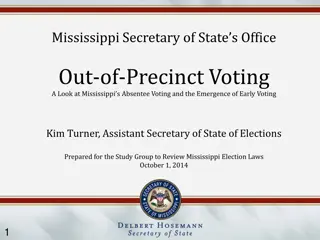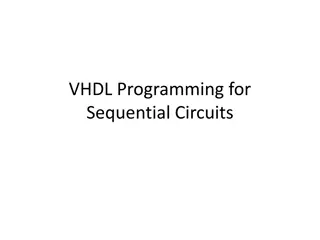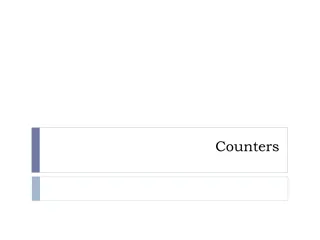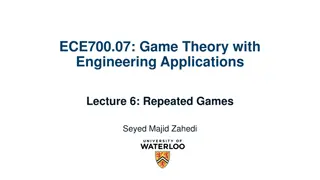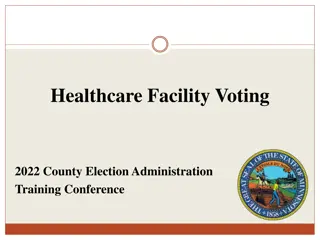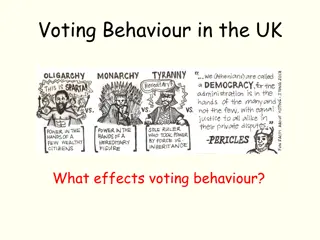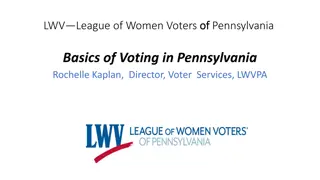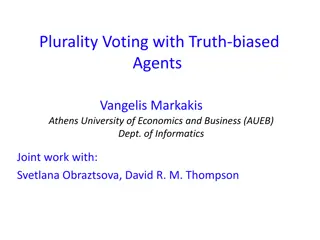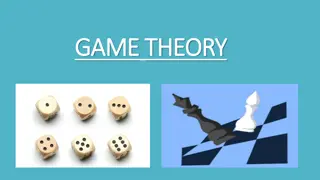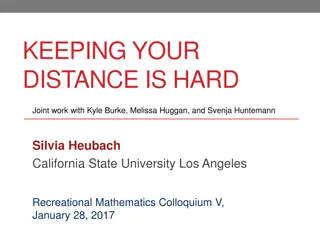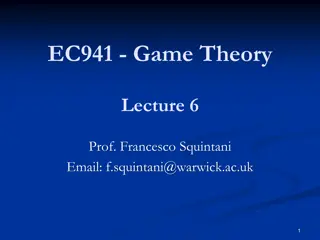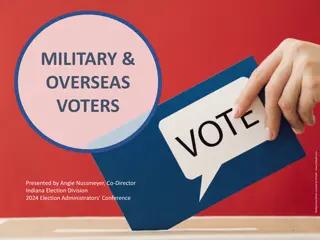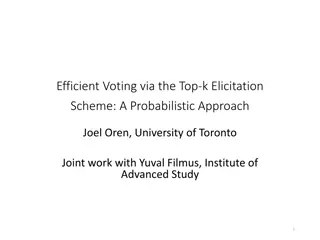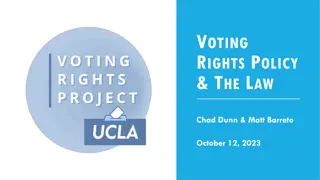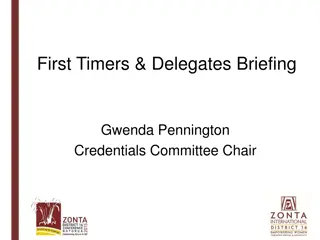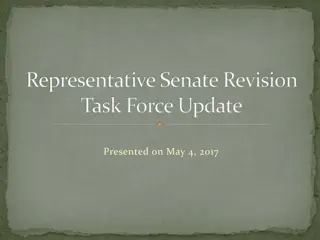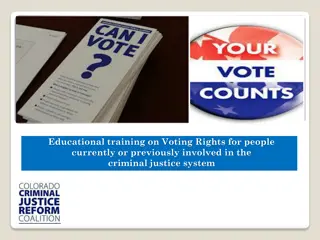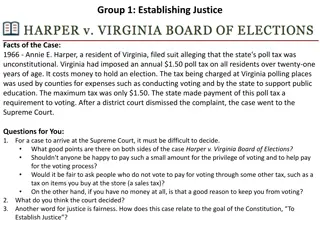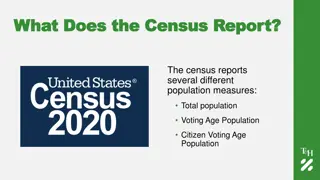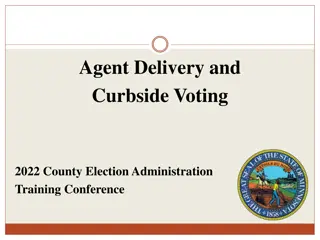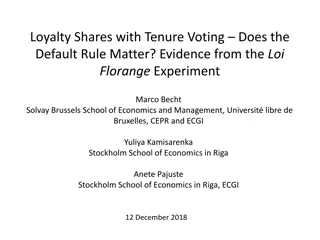Strategic Voting in Sequential Voting Games
Strategic voting in sequential voting games involves voters strategically casting their votes based on information about previous voters' preferences. Various voting rules like Plurality Rule and Borda Rule can result in different outcomes, and the concept of Nash equilibrium is explored. The setting of voters voting sequentially and strategically in a Stackelberg voting game leads to the identification of a unique winner in subgame-perfect Nash equilibrium scenarios.
Download Presentation

Please find below an Image/Link to download the presentation.
The content on the website is provided AS IS for your information and personal use only. It may not be sold, licensed, or shared on other websites without obtaining consent from the author. Download presentation by click this link. If you encounter any issues during the download, it is possible that the publisher has removed the file from their server.
E N D
Presentation Transcript
Strategic voting with thanks to: Lirong Xia J r me Lang
Lets vote! A voting rule determines winner based on votes > > > > > > 1
Voting: Plurality rule Superman : > > > > Obama > : > > > > Clinton > Iron Man McCain Plurality rule, with ties broken as follows: > Nader > Paul 2
Voting: Borda rule Superman : > > > > : > > > > Iron Man 3
Simultaneous-move voting games Players: Voters 1, ,n Preferences:Linear orders over alternatives Strategies / reports: Linear orders over alternatives Rule:r(P ), where P is the reported profile Nash equilibrium: A profile P so that no individual has an incentive to change her vote (with respect to the true profile P) 4
Many bad Nash equilibria Majority election between alternatives a and b Even if everyone prefers a to b, everyone voting for b is an equilibrium Though, everyone has a weakly dominant strategy Plurality election among alternatives a, b, c In equilibrium everyone might be voting for b or c, even though everyone prefers a! Equilibrium selection problem 5
Our setting Voters vote sequentially and strategically voter 1 voter 2 voter 3 etc states in stage i: all possible profiles of voters 1, ,i-1 any terminal state is associated with the winner under rule r At any stage, the current voter knows the order of voters previous voters votes true preferences of the later voters (complete information) rule r used in the end to select the winner We call this a Stackelberg voting game Unique winner in subgame perfect Nash equilibrium (not unique SPNE) the subgame-perfect winner is denoted by SGr(P), where P consists of the true preferences of the voters 7
Voting: Plurality rule Superman : > > > > Obama > : > > > > Clinton > Iron Man McCain Plurality rule, where ties are broken as > O Superman Nader M O P N C O C C C C > Iron Man Iron Man Paul C O C O (M,C) C (M,O) O (O,C) O (O,O) O 8
Literature Voting games where voters cast votes one after another [Sloth GEB-93, Dekel and Piccione JPE-00, Battaglini GEB-05, Desmedt & Elkind EC-10] 9
Key questions How can we compute the backward- induction winner efficiently (for general voting rules)? How good/bad is the backward- induction winner? 10
Computing SGr(P) Backward induction: A state in stage i corresponds to a profile for voters 1, , i-1 For each state (starting from the terminal states), we compute the winner if we reach that point Making the computation more efficient: depending on r, some states are equivalent can merge these into a single state drastically speeds up computation 11
An equivalence relationship between profiles The plurality rule 160 voters have cast their votes, 20 voters remaining 50 votes x>y>z 30 votes x>z>y 70 votes y>x>z 10 votes z>x>y (80, 70, 10) 31 votes x>y>z = 21 votes y>z>x 0 votes z>y>x (31, 21, 0) x y z This equivalence relationship is captured in a concept called compilation complexity [Chevaleyre et al. IJCAI-09, Xia & C. AAAI- 10] x y z 12
Paradoxes : > > > > : > > > > Plurality rule, where ties are broken according to > > > > The SGPluwinner is Paradox: the SGPluwinner is ranked almost in the bottom position in all voters true preferences 13
What causes the paradox? Q: Is it due to the bad nature of the plurality rule / tiebreaking, or it is because of the strategic behavior? A: The strategic behavior! by showing a ubiquitous paradox 14
Domination index For any voting rule r, the domination index of r when there are n voters, denoted by DIr(n), is: the smallest number k such that for any alternative c, any coalition of n/2+k voters can guarantee that c wins. The DI of any majority consistent rule r is 1, including any Condorcet-consistent rule, plurality, plurality with runoff, Bucklin, and STV The DI of any positional scoring rule is no more than Defined for a voting rule (not for the voting game using the rule) Closely related to the anonymous veto function [Moulin 91] n/2-n/m 15
Main theorem (ubiquity of paradox) Theorem 1: For any voting rule r and any n, there exists an n-profile P such that: (many voters are miserable) SGr(P) is ranked somewhere in the bottom two positions in the true preferences of n-2 DIr(n) voters (almost Condorcet loser) if DIr(n) < n/4, then SGr(P) loses to all but one alternative in pairwise elections. 16
What do these paradoxes mean? These paradoxes state that for any rule r that has a low domination index, sometimes the backward-induction outcome of the Stackelberg voting game is undesirable the DI of any majority consistent rule is 1 Worst-case result Surprisingly, on average (by simulation) # { voters who prefer the SGr winner to the truthful r winner} > # { voters who prefer the truthful r winner to the SGr winner} 18
Simulation results (a) (b) Simulations for the plurality rule (25000 profiles uniformly at random) x-axis is #voters, y-axis is the percentage of voters (a) percentage of voters where SGr(P) > r(P) minus percentage of voters where r(P) >SGr(P) (b) percentage of profiles where the SGr(P) = r(P) SGr winner is preferred to the truthful r winner by more voters than vice versa 19 Whether this means that SGris better is debatable
Outline Stackelberg Voting Games: Computational Aspects and Paradoxes TOPIC CHANGE! CAUTION Strategic Sequential Voting in Multi-Issue Domains and Multiple-Election Paradoxes
Voting over joint plans [Brams, Kilgour & Zwicker SCW 98] The citizens of LA county vote to directly determine a government plan Plan composed of multiple sub-plans for several issues E.g., # of candidates is exponential in the # of issues 22
Combinatorial voting: Multi-issue domains The set of candidates can be uniquely characterized by multiple issues Let I={x1,...,xp} be the set of p issues Let Di be the set of values that the i-th issue can take, then C=D1 ... Dp Example: Issues={ Main course, Wine } Candidates={} { } 23
Sequential rule: an example Issues: main course, wine Order: main course > wine Local rules are majority rules V1: > , : > , : > V2: > , : > , : > V3: > , : > , : > Step 1: Step 2: given , is the winner for wine Winner: ( , ) 24
Strategic sequential voting (SSP) Binary issues (two possible values each) Voters vote simultaneously on issues, one issue after another according to O For each issue, the majority rule is used to determine the value of that issue Game-theoretic aspects: A complete-information extensive-form game The winner is unique (computed via backward induction) 25
Strategic sequential voting: Example S T In the first stage, the voters vote simultaneously to determine S; then, in the second stage, the voters vote simultaneously to determine T If S is built, then in the second step so the winner is If S is not built, then in the 2nd step so the winner is In the first step, the voters are effectively comparing and , so the votes are , and the final winner is 26
Voting tree The winner is the same as the (truthful) winner of the following voting tree vote on s vote on t Within-state-dominant-strategy-backward-induction Similar relationships between backward induction and voting trees have been observed previously [McKelvey&Niemi JET 78], [Moulin Econometrica 79], [Gretlein IJGT 83],[Dutta & Sen SCW 93]
Paradoxes: overview Strong paradoxes for strategic sequential voting (SSP) Slightly weaker paradoxes for SSP that hold for any O (the order in which issues are voted on) Restricting voters preferences to escape paradoxes 28
Multiple-election paradoxes for SSP Main theorem (informally). For any p 2 and any n 2p2 + 1, there exists an n-profile such that the SSP winner is Pareto dominated by almost every other candidate ranked almost at the bottom (exponentially low positions) in every vote an almost Condorcet loser Other multiple-election paradoxes: [Brams, Kilgour & Zwicker SCW 98], [Scarsini SCW 98], [Lacy & Niou JTP 00], [Saari & Sieberg 01 APSR], [Lang & Xia MSS 09] 29
Is there any better choice of the orderO? Theorem (informally). For any p 2 and n 2p+1, there exists an n-profile such that for any order O over {x1, , xp}, the SSPO winner is ranked somewhere in the bottom p+2 positions. The winner is ranked almost at the bottom in every vote The winner is still an almost Condorcet loser I.e., at least some of the paradoxes cannot be avoided by a better choice of O 30
Getting rid of the paradoxes Theorem(s) (informally) Restricting the preferences to be separable or lexicographic gets rid of the paradoxes Restricting the preferences to be O-legal does not get rid of the paradoxes 31
Agenda control Theorem. For any p 4, there exists a profile P such that any alternative can be made to win under this profile by changing the order O over issues When p=1, 2 or 3, all p! different alternatives can be made to win The chair has full power over the outcome by agenda control (for this profile)
Conclusion Sequential voting games (either voters or issues sequential) avoid equilibrium selection issues Paradoxes: Outcomes can be bad (in the worst case) Thank you for your attention!








